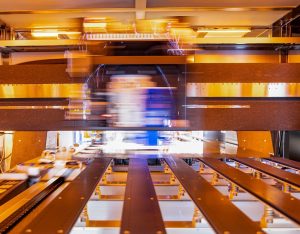Inkjet printing has become a mature manufacturing equipment option for advanced display technologies. Valued for reliability in mass production, it became an enabling solution for mobile OLED TFE – a breakthrough that launched a new class of foldable displays.

Display innovation. Enabled by OLED technology
With this early success, display leaders are now exploring inkjet to enable advanced pixel printing applications for products like TVs, laptops, and automotive screens. The technology’s scalability is due, in part, to complex print algorithms that give manufacturers unprecedented capabilities to achieve their design goals across different display technologies.
As the pioneer of inkjet for mobile OLED TFE mass production, Kateeva’s investment in print software technologies and expertise was a strategic priority from the start. We knew that OLED TFE represented just the tip of inkjet’s potential as a powerhouse manufacturing tool. We also knew that equipping inkjet for the rigors of mass-producing emerging display technologies relied on continuous software innovation and hardware ingenuity.
Take pixel printing, for example. It is a technique that Kateeva developed and refined over the last decade. It involves the deposition of material by inkjet into pixels or subpixels that make up a display. Think of pixels as tiny buckets that hold the ink. Every display contains millions of pixels. In many displays, the pixels are comprised of red, green, and blue (RGB) subpixels. In OLED displays, individual subpixels can be commanded to emit light at different levels. This creates the image shown on the screen.
The goal of pixel printing with inkjet is to create uniform layers of a defined thickness (often measured in nanometers) and thickness tolerance within each subpixel. Ink must be dropped into each pixel location with exquisite precision. The process must meet customer-specified target volumes/tolerances for each subpixel at an acceptable takt speed with high uptime and minimal-to-no operation intervention.
No small task!
Printing in Dramatic Dimensions
Kateeva first applied inkjet to OLED TFE for mobile phone displays which measure around 6″ diagonally and between 4-16 microns in thickness. The display is the same size as the TFE film. Each film is comprised of hundreds of thousands of drops. A typical single sheet of mother glass (1/2 Gen 6) carries 100 to 150 displays for printing.

Kateeva’s YIELDjet® platform
The challenge for pixel printing rises dramatically as the target area to place the drops is much smaller. For a 65″ 4K TV, the zone to be filled with ink (subpixel) is usually below 150 microns –three orders of magnitude less than the size of a TFE film. A single 4K RGB display print takes just under 25,000,000 subpixels. For a sheet of Gen 8-size glass that can carry displays in myriad sizes, the number of subpixels for a single print soars beyond 100 million.
That’s a massive number of tiny buckets to be filled with ink!
Kateeva mobilized with advanced pixel-printing capabilities developed over a decade as display technologies evolved. Our SmartMixing® algorithms combine data from printer sub-systems with our proprietary calibration, drop and print metrology systems, and print-generation and control software. The collective information is used to optimize printer performance and achieve accurate and uniform deposition of inks into many millions of subpixels on a single sheet of glass.
Benefits. In Print
While inkjet’s advantages depend on the type of display technology, many benefits are common to any inkjet-printable pixel technology.
Flexibility is a big one. Inkjet can deposit layers with diverse thickness levels ranging from less than a micron to many microns. It can adapt easily, even on a single sheet of mother glass with myriad subpixel shapes and deposited volume requirements. The volume of a red pixel, for example, can be easily set to differ from a green or blue pixel. Furthermore, with Kateeva’s advanced pixel-printing algorithms, if there is a change in pixel dimensions or volume between different-sized displays on a mother glass, no adjustments are needed since each display is described uniquely in the recipes that drive Kateeva’s software capabilities.
Material efficiency is another advantage since inkjet deposits only the required amount of material into each pixel well.
Finally, inkjet adapts easily to glass size. From R&D tools printing on 200mm x 200mm substrates, to mass-production tools printing on Gen 8 (2200mm x 2500mm) substrates and above, the same Kateeva software algorithms and inkjet technology apply. This means that the technology common to Kateeva’s YIELDjet® Kuna, Tioga and Jarvis inkjet tools can take manufacturers from R&D all the way to high-throughput mass production.
YIELDjet and SmartMixing are registered trademarks of Kateeva, Inc.
 简体中文
简体中文 한국어
한국어 English
English
